In the near future, more no-tillers and strip-tillers than ever before will be able to purchase cutting-edge, cover-crop seeding machines that used to be reserved for field days, research farms and expert welders.
Major names like Hagie Mfg., Salford Equipment and Dawn Equipment are plunging into the cover-crop seeding business, while a mix of grassroots startup companies are also getting involved.
No-Till Farmer editors have assembled the latest, most cutting-edge, cover-crop seeding tools hitting fields this year — many of them featured at the 19th annual Cover Crops Solutions Cover Crop and Soil Health Field Days last fall in Holtwood, Pa.
Three-In-One Cover Crop Seeder Does It All
Four years of research and testing led to the development of the Cover Crop Interseeder and Applicator, a semi-mounted machine that can seed cover crops into standing corn, sidedress nitrogen and apply herbicides in one pass.
The unit was developed by Cory Dillon, Chris Houser, Penn State weed scientist Bill Curran and Penn State agronomist Greg Roth.
Dillon builds and fabricates research machinery at the Penn State University’s Russell Larson Research and Education Center at Rock Springs, Pa., and is working on his masters in agronomy, while Houser works as a Penn State Extension educator and holds a master’s degree in agronomy from the university.
Interseeder Technologies, formed through the team that developed the machine, will be producing units for the ag market this year.
The seeder’s development began 4 years ago, when Penn State agricultural scientists built a prototype of the three-in-one tool. No-tillers in the area were having inconsistent stands with cover crops due to variable moisture or slugs devastating emerging seedlings.
Cover crops have also been explored to meet increasing demand for dairy forage and to replace carbon loss as corn stover is harvested for biofuels, the scientists say. Attempts to use cereal rye to replace the carbon suffered because the cover couldn’t be seeded early enough for full growth.
An early-model interseeder from 2011 had three 2-inch wavy coulters to cut a band between rows for the broadcasted seed, along with two 100-gallon tanks to carry nitrogen and herbicide, a fertilizer coulter for sidedressing and packing wheels to firm loosened soil.
The latest machine is designed to no-till seed into standing corn at the V4 to V8 stage and complete two other tasks at the same time: apply liquid UAN about 4 inches off the corn row and adjacent to the first row of drilled cover crop seed; and applications of glyphosate in Roundup Ready corn to the area between the 30-inch rows.
Esch Mfg. of Lancaster, Pa., built the double-disc openers and seed box, Penn State built the frame and a Great Plains Turbo-Till blade is used in front of the row units, although any coulter design could be used. A packing wheel seals in the cover-crop seed.
The company will set 10- and 15-foot models and larger units are coming in the future. There are 30-inch-wide gaps for the corn rows and three row units at 7.5-inch spacing between the gaps.
Dillon believes the 4-inch space off the corn row for sidedressing nitrogen should be close enough for corn roots to reach the nutrients in a dry year, but far enough away to avoid burning the seed.
The idea, he says, is that no-tillers can seed cover crops and sidedress nitrogen in midsummer, before corn gets past the knee-high stage and there’s enough sunlight for the seed to germinate and emerge.
The closing corn canopy should control cover-crop growth enough to avoid a yield penalty, then the cover crops will begin to grow as the corn dries down and more light comes into the inner row closer to harvest.
In 4 years of research, the scientists had accomplished an acceptable cover-crop stand 85% of the time with this interseeder. They haven’t documented a negative impact on corn yields, noting the issue is usually whether or not the cover survives under the canopy.
“The last few years in Pennsylvania, we’ve had droughts that lasted from early July through August, but we usually pick up fall rains and find that the cover crop takes off and does well,” Dillon says.
Clarion, Pa., farmer Scott Reinhart told attendees at the Cover Crop Solutions Field Day last October that the machine could even be used to apply fungicides or foliar fertilizer with the sidedress passes, adding two more potential uses for the machine.
Dillon and Houser also updated the patent to add another row unit between the corn rows so growers can drill solid-seeded beans or wheat. When the interseeder is not being used for interseeding, there is an option to add additional row units on the machine to make it a no-till drill.
“They should be able to seed anything from clover and alfalfa to cereals in the fall to soybeans in spring,” Dillon says. “Rather than having a machine that’s used 2 weeks out of the year, we’re hoping no-tillers can use it 2 months out of the year.”
Researchers have used the machine to seed annual ryegrass and legumes such as clover or hairy vetch, and have also worked with radishes and mixes.
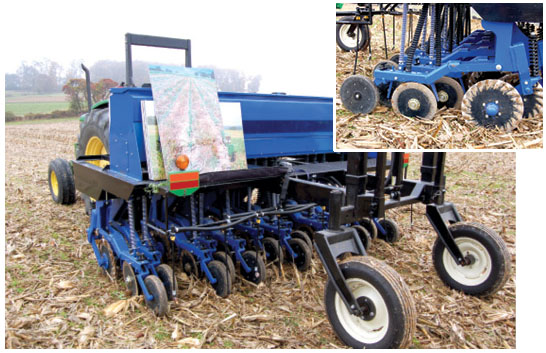
“The seed box is large enough to run over a lot of acres with cover-crop seed,” Dillon says. “The limiting factor is when you apply a full rate of UAN that will need to be refilled more often.
“We’ve done herbicide studies with annual ryegrass and found metolachlor has been tough on establishment. Additional research has to be done before recommendations can be made to address safety issues with residual herbicides.”
When drilling, researchers used slightly less than half the rate of annual-ryegrass seed than with aerial-seeded applications. They used rates in 2013 as high as 20 pounds an acre with annual ryegrass, 12 pounds for clover or 20 pounds for hairy vetch, but used smaller rate and still had acceptable stands in the past, Dillon says.
When using the seeder in an in-crop, cover-crop seeding concept, they like to use a burndown of paraquat and 2,4-D ahead of planting Roundup Ready corn, then use glyphosate in-crop for weed control.
Through previous testing with the interseeder, researchers found:
Corn yields can increase by as much as 7 bushels an acre due to a rotational effect from planting corn into a grass/legume sod.
Nitrogen use can be reduced by 50 pounds an acre with legume cover crops, for a $32.50 benefit per acre with nitrogen costs at 65 cents per pound.
An increase in fall forage from cover crops by an estimated 1 ton, at $100 per ton.
Combining sidedressing and post-emergence spraying ($10 per acre each) and cover-crop planting ($19 an acre) into one interseeder trip ($20 per acre) can produce a net benefit of $19 per acre.
Take Cover From The ‘Rowbots’
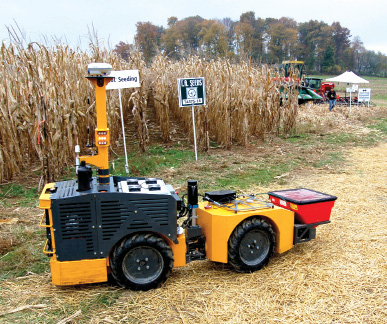
If all goes according to plan, a small brigade of yellow machines will be snaking through corn rows on dozens of farms across the Corn Belt this summer as the era of autonomous farming marches ever closer.
The exact plans are still unfolding, but the company hopes to have as many as 10 Rowbot applicators making their debut as soon as this year on potentially 5,000 farm acres, or up to 50 farms, offering the capability of broadcasting cover crops or sidedressing fertilizer between rows of corn.
A prototype of the machine was debuted last fall at the Cover Crop Solutions field day.
The plan for Minneapolis, Minn.-based Rowbot Systems is to field a service team that will deploy the machines to sidedress and/or seed cover crops on standing corn acres at a cost of $10 an acre for sidedressing and $15 an acre for seeding covers, says Kent Cavender-Bares, CEO and co-founder of Rowbot.
The Rowbot machines have diesel power, a hydraulic four-wheel-drive system and were GPS guided, although a sensor-based system may be in place this year.
The 20- to 22-inch-wide, 7-foot-long machines have a 40-gallon aluminum tank for sidedressing UAN and four nozzles on the rear, along with a small seed hopper for cover-crop seed.
The goal is to have up to 5 or 10 of the units working on a 160-acre field, running 24/7 and returning to a docking station automatically to be refilled. Each unit could possibly cover 50 acres per day.
Cavender-Bares says Rowbot was founded in May 2012 with brother Charlie Bares, a New York dairy farmer, and another brother, John Bares, CEO and founder of Pennsylvania based Carnegie Robotics — which was spun off Carnegie Mellon University’s National Robotics Engineering Center.
“We founded the company to solve a nitrogen problem in corn,” Cavender-Bares says. “Right now, as a country, we waste about half the nitrogen that is applied on corn acres. More growers should be applying nitrogen in-season, but don’t because it’s not easy and there are various risks.
“We’ve studied this issue and it’s pretty clear that the height of the crop creates a barrier. But the Rowbot is an in-row solution that doesn’t have height of crop as an issue,” Cavender-Bares says. “I think this will be a slick platform to get in fields in late August or early September and seed covers without conflicting with harvest.
“We think it will have a huge competitive advantage to aerial seeding, in terms of cost and quality.”
Get Your ‘Head’ In The Cover-Crop Game
Ray McCormick, a veteran no-tiller from Vincennes, Ind., raised some eyebrows 2 years ago when he fastened a small Gandy air seeder to his John Deere corn head so he could seed annual ryegrass during corn harvest.
The idea has since come full circle, as Owatonna, Minn.-based Gandy Co. has released its 1018 Orbit-Air No-Till Cover Crop Seeder.
Gandy’s new 10-cubic-foot, 18-outlet machine lets no-tillers seed covers like annual ryegrass, turnips, radishes and more in a single pass.
The seeder features a heavy-duty, 12-volt, 25-amp, electric-drive motor and two banks of meter wheels equipped with electric clutches. These let the operator to turn each bank of nine metering wheels on or off from the in-cab console.
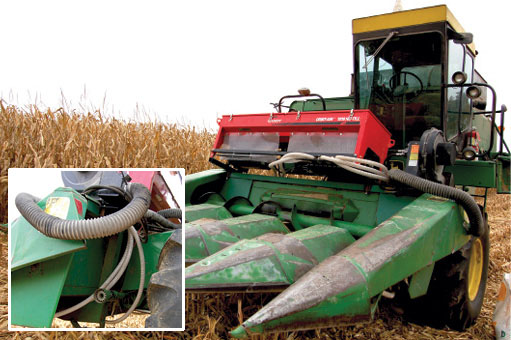
Air pressure and metering shafts are also monitored and controlled from inside the cab. The system includes a run/hold switch that mounts between the combine and header that automatically turns the metering system on when the head is lowered, and off when head is raised.
A 4-gallon-per-minute remote hydraulic blower allows operators mount the blower in the most convenient location. Rate settings are achieved with Gandy’s Zero-Max rate controller, with rates adjusted by turning the speed-control knob to the desired setting.
The seeder comes with a steel mounting frame that allows the unit to be bolted or secured with U-bolts to a customer-supplied mounting platform. The 18-outlet deflector package includes deflectors and angle-iron mounting straps to broadcast seed under or behind the header.
Get Covers In Touch With Dirt
Vertical-tillage tools are one means some no-tillers are using to incorporate certain cover crops into the soil and improve germination. But those processes take multiple passes when done separately.
But a few years ago, farm-equipment dealers Gary Fennig of Fennig Equipment and Droesch Farm Services founder Don Droesch pioneered a new setup: a Valmar air seeder mounted onto a Salford Machinery vertical-tillage implement.
This setup lets no-tillers manage crop residue and seed cover crops and incorporate them in one pass.
“When you get a little dirt mixed in with a cover crop, the germination rate is faster than with a fly-on approach or a highboy that goes into standing corn, or when you’re relying on the weather,” says Fennig, whose Coldwater, Ohio-based dealership is a major U.S. distributor for Valmar seeders. “Cover-crop seed is expensive, so why rely on the weather to do the rest when you can lightly work ground a couple of inches and up get the seed to germinate?
“But you do need to be careful about how much dirt you get incorporated with the seed.”
The machine could come in handy after a wheat crop is harvested to seed summer cover crops and shield and protect soils, or after no-tilled soybeans to replace cover where residue levels might be lighter.
Salford reports that its RTS model and Valmar seeders are being used not only for cover crops, but also with small-seeded crops like barley, canola and wheat.
Fennig says three models of seeders can be used with a vertical-tillage tool in this fashion: the 1655 with 16 outlets, good for 15- to 20-foot-wide tools; the 2455 with 24 outlets for 25- to 30-foot machines; and the 3255 with 32 outlets for units up to 60 feet wide.
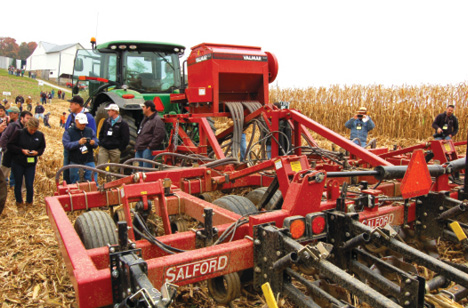
Ron Linn has been using a Valmar 1655 air seeder mounted on a 24-foot Great Plains Turbo-Till for the past 3 years to seed cover crops on his farm near Celina, Ohio. He raises poultry and no-tills 850 acres of corn, soybeans and wheat with the help his father Terry and brother Dave.
Last year was the first time he seeded cover crops onto 100% of his farm ground with the vertical-tillage/air-seeder combination after trying various methods of seeding over the past 7 years.
“We were mixing cover crops with fertilizer, but not getting a very nice spread. The covers would go 30 feet and the fertilizer 50 feet, then we’d incorporate it with the Turbo-Till,” Ron says.
Last summer, the Linns hired VanTilburg Farms in Celina to seed a mix of annual ryegrass, radishes and clover with highboy seeders into standing corn, but a lack of moisture that month prevented germination.
After soybean harvest was finished around Oct. 12, the Linns used the Turbo-Till/Valmar unit to seed 12 pounds an acre of annual ryegrass into ground going to corn. They also followed the combine during corn harvest a week or so later, seeding 63 pounds of cereal rye per acre for fields going to soybeans.
The cereal rye and annual ryegrass will be killed off in the spring with glyphosate prior to planting.
“The annual ryegrass emerged well, except for being thin in some of the late-seeded fields, and the cereal rye looks really good,” Ron says. “This was the year Mother Nature cooperated with us, although she didn’t help us out in August.”
The Linns have been using vertical tillage to transition away from conventional tillage of corn ground. They have seen up to a 1% increase in soil organic matter in some fields they have transitioned to no-till.
Their Turbo-Till has a standard setup with a straight coulter and rolling basket that’s used to loosen the soil about an inch deep for corn.
“We just want to size residue and not turn up more dirt than necessary, but it does a good job of incorporating the cover-crop seed,” Ron says.
Roller, Planter Toolbar Defines ‘Planting Green’
Typically, no-tillers raising corn or soybeans terminate cover crops in the spring, a couple of weeks before planting, which caps the biomass production of overwintering covers.
But 3 years ago, Loysville, Pa., no-tiller Charles Martin developed a special toolbar for his John Deere 7000 planter that lets him roll, crimp and terminate cover crops while no-tilling cash grain or forage crops in the same pass.
This setup allows more time for cover-crop biomass accumulation and enhancement of soil health.
Sycamore, Ill.-based Dawn Equipment announced last year that it came to an exclusive licensing agreement with Martin and his family to commercialize the unit, with the first units coming out this spring.
Dawn president Joe Bassett says the roller/planter will become part of a system of products for cover-crop-intensive farming through the company’s newly conceived “DawnBiologic” division.
“We think there are a lot of farmers in the 100- to 500-acre category that haven’t previously been Dawn clients,” Bassett says. “This clientele — especially on the Coasts where there exists higher environmental regulatory pressure — are early adopters of covers.
“The DawnBiologic division will be looking at these markets. We probably will focus on smaller equipment to begin with.”
The toolbar Martin designed includes row-cleaner-type attachments, or opening discs, out front that clear a path in the soil for seed. Behind the opening discs, 6-inch-diameter rollers with crimping blades roll down the cover crop ahead of planting.
Each roller is separate between each row so they follow ground terrain. Behind the rollers, a no-till coulter chops up the cover before the planter row unit does its work.
Experts believe the machine has potential because winter-hardy legumes like hairy vetch and some clovers will produce significantly more nitrogen for the following crop when allowed to grow for a longer period of time.
In addition, actively growing grasses and other covers will take up more available nutrients due to a deeper and larger root system, resulting in improved nutrient cycling and reduced nutrient loss.
A cover crop allowed to grow longer could also help no-tillers manage excess soil moisture during the spring planting season and possibly allow for earlier planting.
An additional benefit could occur with slug management, experts say, as slugs may prefer to feed on the cover crop instead of the primary crop during its establishment.
“I’ve been in residue management for a long time and never seen anything more difficult to plug,” Bassett says. “If we went out there with our best residue-manager configurations, it would take only about 6 feet to wrap it.
“With this, you’re not using a row cleaner in the standard sense, but pushing residue out to the side, where the roller grabs it and pulls it away.”
The system does well keeping residue from falling back over the top of the row, Bassett says. Strip-till might be one market where the machine will get consideration.
“Strip-tillers know you can make a clear path, but if the wind blows residue back on top, it can hurt emergence,” Bassett says. “I like this design because the roller is effectively gauging the depth of the row cleaners, so they’re not moving much dirt at all.”
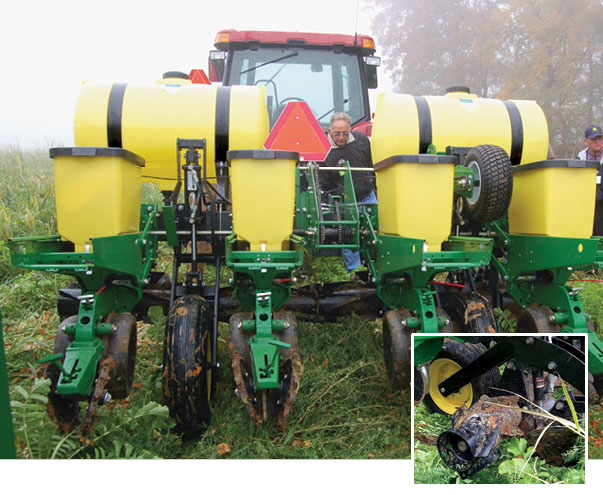
Take The High Road When Seeding Cover Crops
For no-tillers in the Corn Belt seeding cover crops on thousands of acres, their best option, in addition to aerial seeding, may still be a highboy seeder.
VanTilburg Farms of Celina, Ohio, and Martin are among those who have pioneered the design and use of these machines. Manufacturers have taken note.
Following research and onfarm testing, Hagie Mfg. will roll out three options this year to help no-tillers seed cover crops into standing corn and soybeans. They include:
A complete highboy cover-crop interseeder with an 80-cubic-foot dry box and hoses affixed to a boom spanning 60 or 90 feet. Plates at the bottom of the tubes help disperse the seed and achieve an even spread pattern.
A version of the company’s NTB nitrogen toolbar that can be outfitted with hoses and a Gandy air seeder to fit onto an existing Hagie sprayer. The toolbar includes special attachments at the bottom of the arms to incorporate the cover-crop seed.
A special kit, whose design was customer driven, that allows growers to retrofit existing NTB toolbars to apply both nitrogen and seed cover crops simultaneously into standing crops.
The company feels the standalone highboy machine will be popular with custom applicators and co-ops because the wider boom will cover more ground quickly. Hagie already has fielded several requests for the highboy unit.
Hagie began exploring options for cover-crop equipment in 2012, when the company was approached by a farmer in central Illinois wanting an interseeder to seed covers into standing corn, says Hagie agronomist Rachel Halbach.
Crews took one of the company’s NTB toolbars, removed the coulters and attached two different seeding units to the bar. One broadcasted clover, radishes and cereal-rye seed under the crop canopy; the other broadcasted the covers, but used small cultipacker-type wheels to incorporate it.
They also attached a cutter apparatus from their detasseling units on the toolbar that cut off the top foliage of plants to create a mulch on the soil surface.
“We got good germination with that, but in talking to farmers, there was some concern about stressing plants at that stage,” Halbach says.
They also noticed that north-south-oriented corn rows produced about 20% more cover-crop tonnage, with the reduction in tonnage of east-west rows possibly due to shading, Halbach says.
Last year, Hagie worked with Beck’s Hybrids and Indiana no-tiller Cameron Mills tested a prototype highboy, taking off the liquid tank and placing an 80-cubic-foot Gandy seeder in its place. The machine also had a 60-foot boom and hoses with drop tubes every 30 inches to broadcast cover-crop seed.
On two fields, Mills compared ground application of annual-ryegrass seed vs. aerial application.
“Annual ryegrass broadcasted below the corn canopy at 18 pounds an acre produced as many or more seedlings per square foot as aerially applied ryegrass at 25 pounds an acre,” Halbach says. “Ground application provided more consistent cover-crop growth across all acres, where aerial application had areas — especially in field depressions — that had few to no germinated seedlings.”
Additionally, Hagie took the different version of the toolbar, with half containing cultipacker wheels and the other half with rolling baskets with aggressive teeth.
They ran it through standing soybeans on the company’s research field in Iowa, seeding radishes in mid-September as soybean plants were beginning to yellow.
“I was nervous because I thought the soybeans would be pulled into the equipment and we’d have a mess on our hands, but it ran really smoothly,” Halbach says. “However, when it rained, all of the cover crops germinated and it didn’t appear to matter if they were in the more aggressive incorporating treatment or not.
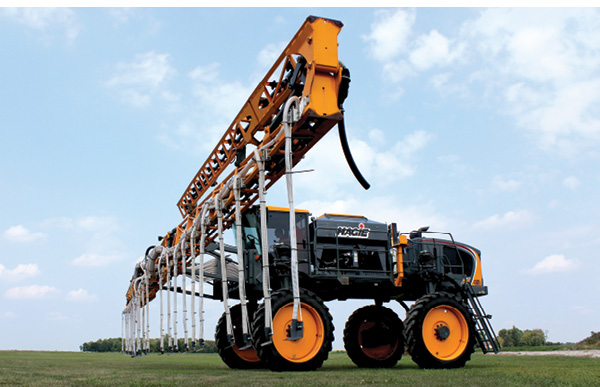




Post a comment
Report Abusive Comment